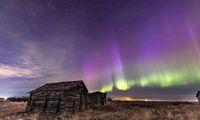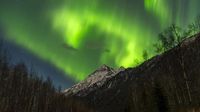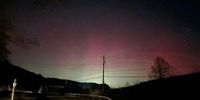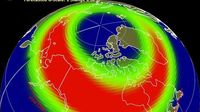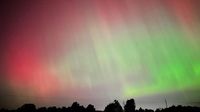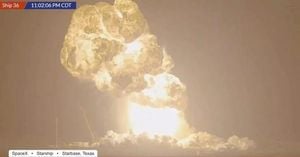A strong geomagnetic storm is set to sweep across a significant portion of the United States and parts of Canada this weekend, offering a rare opportunity for many to witness the spectacular phenomenon of northern lights. According to the National Oceanic and Atmospheric Administration’s (NOAA) Space Weather Prediction Center (SWPC), the northern lights may be visible late Saturday night, March 22, 2025, continuing into the early morning hours of Sunday, March 23, 2025.
This anticipated display is classified as a G3 geomagnetic storm, a classification which indicates strong solar activity. Experts predict this level of activity could allow the northern lights to extend visibility into states not typically graced by this breathtaking natural display. "A strong geomagnetic storm is expected to produce a much stronger northern lights show than usual," NOAA announced, emphasizing the potential excitement for stargazers.
The key to this dazzling display lies in a coronal mass ejection (CME) that erupted from the sun’s surface on Friday, March 21. If aimed correctly at Earth, these eruptions, which consist of a colossal release of plasma and magnetic field, can lead to significant geomagnetic activity. Upon their arrival, these particles interact with Earth's magnetic field, resulting in the vivid displays associated with the auroras.
The timing of the CME arrival aligns perfectly with ideal viewing conditions. The SWPC forecasts indicate that the best chances to spot the northern lights will likely be between 10 p.m. and 2 a.m. local time, perfectly positioned for the ambitious night owl. As you prepare for this cosmic spectacle, NOAA reiterated that conditions ultimately rely heavily on the weather; clear skies will enhance the viewing possibilities.
Regions across New England, including Vermont, New Hampshire, and even Massachusetts, could see the lights. The entire expanse of Alaska is also expected to have a high likelihood of visibility, making it an exciting time for residents and travelers alike. Affected states also include parts of Michigan, where the SWPC stated that, "If the forecast verifies, it would likely be strong enough to produce aurora across most of Michigan under ideal viewing conditions." Additionally, the lights might extend as far south as areas like Oregon and even Iowa, which typically rarely experience this phenomenon.
Tim Brothers, a Technical Instructor and Observatory Manager at the Massachusetts Institute of Technology, provided guidance for those looking to catch a glimpse of the northern lights. "We typically suggest getting away from cities and finding an open field or hilltop to lay out under the stars and wait for the show to really peak at the late evening or early morning hours," said Brothers. Such locations can provide the dark sky needed for optimum visibility.
Photographers are advised to prepare as well, employing techniques best suited for capturing this atmospheric artwork. Using a wide-angle lens and stabilizing your camera on a tripod can dramatically improve the quality of photographs taken. Many smartphones today also come equipped with night mode settings that can help capture the stunning colors of the auroras.
As excitement builds around this extraordinary event, it’s worth noting the current state of solar activity. The sun is at solar maximum, which is the peak of its natural 11-year cycle, resulting in heightened occurrences of solar flares and coronal mass ejections. This heightened activity enables more frequent opportunities for aurora sightings. In fact, last year saw these lights hit a 500-year peak, with forecasts indicating that this level of activity could continue through 2026 before declining.
Weather predictions indicate that while certain regions will enjoy clear skies, others might face challenges due to cloud cover. Therefore, enthusiasts are advised to stay updated with the latest weather forecasts while scouting for ideal viewing spots. As NOAA points out, "The lights are best viewed when it is dark outside, particularly between 10 p.m. and 2 a.m. local time." Thus, being patient while observing the skies will likely yield the best results.
Venturing out to witness the northern lights can be both a magical and unifying experience for all. Under ideal conditions, the gradients of green, red, and purple can create a breathtaking display, captivating all who look up. Whether you’re an experienced sky watcher or a curious first-timer, this weekend presents a unique opportunity to engage with one of nature's most dazzling displays.
So, prepare your cameras and plan your evenings accordingly. This is a spectacle that promises not only enthralling beauty but an invitation to consider the grandeur and mystery of our universe. Be sure to share your experiences and photographs, and revel in the wonders of this celestial event!
